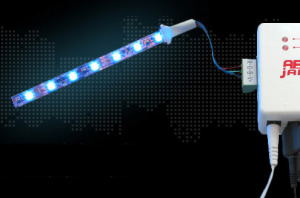Video Review
Digital DJing’s got one feature that has always particularly appealed to me: Portability. You can fit everything you need (if you choose wisely) in a backpack, and literally, it’s “have party, will travel”.
Except, that is, lighting. Wouldn’t it be great to roll up at a house party, and not only set up a laptop or tablet DJ system but also add some professional, impressive lighting – all out of the front pocket of your backpack? Well, it is definitely possible with products like the Apollo Jammer, which we review today.
First impressions/setting up
The Apollo Jammer is a small colour controller, about the size of a couple of packs of cards. It’s lightweight and made of white plastic. There are a few sockets around its sides, a one-digit LED on its top, and two buttons plus two display lights, also on the top.
In the box are a stereo RCA-to-stereo 1/8″ TRS lead, a stereo 1/8″ TRS-to-TRS lead, and a small TRS splitter adaptor, along with a lightweight power transformer. There’s also a one-foot length of flexible RGB strip light to “get you going”; you’ll want to buy a longer section (we tested with a 10-foot section, that rolls up really small, and would be plenty to add lighting to any DJ area).

You have two options for getting lighting plugged into it: You can add strip RGB lighting as we used (there are a plug and adaptor provided, you just need to attach the plug to the lighting strip with a small screwdriver the first time you set it up), or plug in whatever DMX lighting happens to be knocking around in the venue you’re in. It’s good to have the DMX option for bigger shows.
Next, you have to add a music source. It’ll work fine with an iPad (or iPhone etc.) for a truly portable system, and the makers have thought about the need to feed both your speakers and the Apollo Jammer with a sound signal; that’s what the splitter is for. (This is a stereo splitter, not to be confused with mono splitters, which are used for pre-cueing on iOS devices, by the way. You’d probably end up using both in this instance.) Alternatively, if you have a DJ controller or a mixer with two independent outputs (say, a booth and a master) and one of those is spare, you could plug the lighting controller into that instead.
Finally, you plug it into the mains and start the music…
In use
There are ten settings, which the “change mode” button lets you cycle through, and these have various combinations of different lights reacting to different parts of the musical spectrum, and differing fade/decay rates. You’ll just want to mess around with them to see what suits at any given time. You will also want to mess around with the sensitivity. There are four settings for this, represented by the sensitivity LED being off, or set to one of green, red or yellow. This determines how much the lights react to the music, and again you’ll want to experiment and keep the optimal setting chosen as your night progresses.
Once you’re set up, the controller works really well. Obviously, it depends what you plug into it, but its job – to turn the musical information into instructions for the lights – is achieved excellently, and we found it a lot of fun.
Conclusion
Digital DJ gear looks “small”. I always love rolling up somewhere with a ridiculously tiny set-up, watching the looks on people’s faces as I plug in (usually “toy DJ!”), only to have them congratulating me a few songs in for being able to, you know, “DJ on that stuff!”

This, though, takes it all to a whole new level. Now, you can roll up with a passable lighting show in your bag too, at least for house parties or small bars. I think that’s awesome.
It would have been good to have a small microphone built into the Apollo Jammer, to save even having to wire it into your output at all, although I suspect the results wouldn’t have been so good via that route. Also, the splitter thing is not ideal. It’s better to use a separate output for the Apollo Jammer if you can.
Overall, then, this is a cheap, fun, effective and above all, small and lightweight way to add a lighting show to your DJ set-up – a lighting show that looks far bigger than it actually is. If you want to pack the biggest punch possible from as small a set-up as possible, you should definitely consider adding an Apollo Jammer and a strip of RGB lighting to your digital DJ weaponry.
Would you consider adding a portable lighting rig to your gig bag for those impromptu house parties and for adding a bit of punch to your digital DJ set-up? Got any other little lighting tricks you like to use? Please share your thoughts in the comments…






![How To Book DJ Gigs Globally [Live DJing Q&A With Phil Morse] How To Book DJ Gigs Globally [Live DJing Q&A With Phil Morse]](https://cdn.digitaldjtips.com/app/uploads/2023/04/11185205/546960954-book-gigs-blank-website.jpg)

